By Oliver B. Pollak
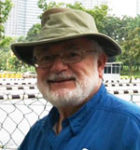
VIENNA, Austria — I am now the same age as my father was when he died, 74. For the first time, I am walking around his birthplace, Vienna, with my sister, gazing at the city he loved and cherished. He hummed his favorite melody Wien, Wien (Vienna, Vienna) which debuted in 1914 when he was 11. My father’s youthful idyllic past was disrupted but not erased as he fled in the 1930s. How are we like our parents in our language, food memories, music tastes, mannerism, likes and dislikes? What do we share in common with our cousins who have the same grandparents? Nature, nurture and experience create an architecture of our multigenerational linked pasts.
The days were filled with walking among Vienna’s wonderland of wide boulevards, narrow cobblestone lanes, rose gardens, and wondrous architecture. Karen’s fitbit logged about seven miles a day.
We dined at Pluchatta; Café Landtmann, established in 1873; Grand Hotel Wien; Nordsee; and so so many cafes. We shared the legendary Sachertorte, but my sister was reluctant to tuck in. At the end of the meal I said, I could live without Sachertorte, it was overrated. Judy sighed with relief and related that she wrote in her diary in 1973 on a trip to Vienna that “It was nothing special.” Some legends sound better than they taste.
We ate Viennese food that never made it to our English and American tables. Boiled meat was delicious, I’d had it before, Vietnamese or should I say Viennese Pho. The strudel lived up to its reputation. Cafes were innumerable, a cup, far too small, cost about $4.
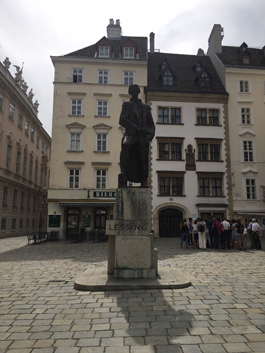
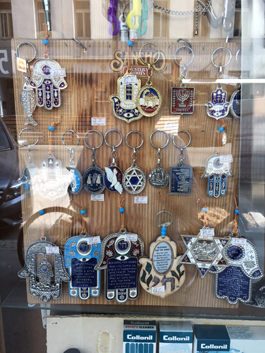
The Internet featured as many as nine classical music, opera, and ballet venues on any given night. Evenings were filled with the strings of Mozart, Strauss, Vivaldi, Bach, and Beethoven at the Schönbrunn Palace, Orangery, and at St Peters. We walked and drove past the imposing Vienna State Opera several times.
Museums are designed to amaze. Museumologists spend years framing the past for citizen and tourist consumption. The book themed Memorial to the Austrian Jewish Victims of the Shoah designed by Rachael Whitehead was completed in 2000. The monument is adjacent to a statue of enlightenment thinker Gotthold Ephraim Lessing, where Juden Platz runs into Jordan Gasse.
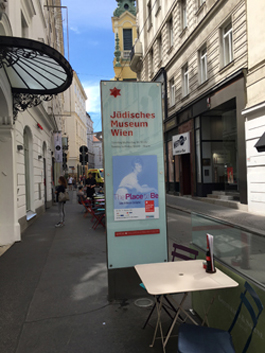
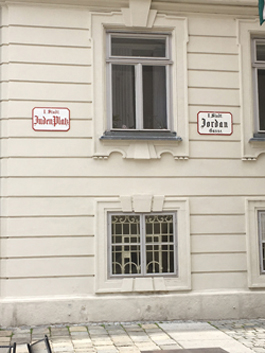
The two Jewish museums, Museum Judenplatz and Jüdisches Museum Wien contain stunning exhibits included the foundation and lower walls of a 15th century synagogue discovered in 1995. The status of women inspired two exhibits, the role of salons in Vienna’s social and intellectual life, and Jewish women making marriages of convenience to foreigners whose passports would provide the new bride escape and asylum in 1938.
The Leopold and Belvedere Museums offered Egon Schiele and Gustav Klimt, and two further wondrous surprises. The work of Zoran Music, a Slovenian Gentile artist sent to Dachau for political reasons was a case of, ‘why haven’t I ever heard of this painter?’ His early 1930s work captured street scenes with disabled panhandlers. His repertoire darkened further with mortuary images of Dachau. Music died in 2005 at 96. Brighter light shone in Heidi Horten’s tastefully grandiose 20th century private collection featuring 75 artists and 170 pieces, including Jean-Michel Basquiat, Damien Hirst, and Lucian Freud as well as Picasso, Calder and a multitude of other familiar geniuses. We visited the Kunst Haus Wien designed by Friedensreich Hundertwasser who we have savored for almost 50 years.
Vienna’s interiors and exteriors are museums of light, shade and dark. The streets and plazas memorialize royalty, politicians, and cultural icons in gold, bronze, and granite atop columns.
Now for the darker side of tourism. Our father and his four sisters fled Vienna and found refuge in New York, Palestine, and England. Their mother, my grandmother, Agnes Pollak, died in 1942 shortly after arriving in the Terezin ghetto in Czechoslovakia, which the Germans called Theresienstadt.
The Österreichische Nationalbibliothek – InfoDesk and Yad Vashem responded quickly to my requests for home addresses. They provided addresses for 1927 (Ausstelungsstraße 19), across from the Prater where my father worked at the giant ferris wheel, and 1942 (Ferdinandstraß 19), both half a dozen story apartment buildings, both in Jewish neighborhoods. Stolpersteines, stumbling stones, memorials to murdered Jews marked sidewalks and walls.
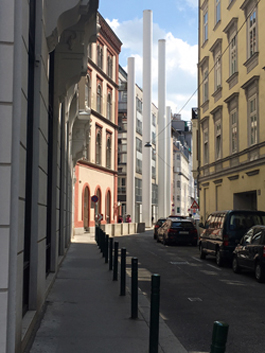
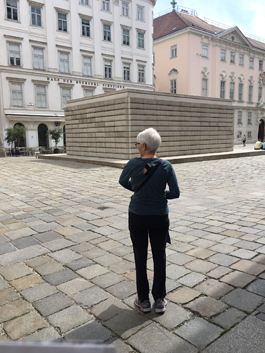
Agnes and Adalbert Pollak lived in Vienna and had at least five children, all escaped from Austria and had children of their own. Agnes had at least six grandchildren, two of whom she embraced before she died as Agnes Sara in Terezin in 1942. Two carry Adalbert (Bert) and Agnes as their middle names. There are thirteen great grandchildren, and a growing cohort of great great grandchildren in Canada, Israel, and America. The address just prior to deportation to Terezin was around the corner from a grand synagogue destroyed in 1938. Today it is the site of a Jewish educational center. In front are five white columns. My wife says the signage states this is in memory of the destroyed majestic synagogue. I think the subtext is crematorium chimneys.
The Vienna Central Cemetery contains a huge Jewish section. Grandfather Adalbert died in 1927 and is buried way in the back among many weeds. I almost gave up looking for 12:11:75. My wife recruited the Serbian groundskeeper who found the stone with substantial difficulty. Time has not been kind to the lettering on the stone, though it revealed that Agnes had been added to to the stone sometime after the war. The stone was refurbished within 48 hours.
We did things we wanted to. We did things we hadn’t planned. We did not ride in one of the several horse drawn carriages, but we did use uber (Tesla, Mercedes, Hyundai, and VW). We missed the Freud Museum, tourists can’t do everything. We went to Freud’s London museum. Some of Freud’s family perished in Terezin.
Our ancestor legacy tour of Germany, the Czech Republic and Austria has come to a turning point. As experiences and suitcases are unpacked memories about memories will be further pursued through souvenirs purchased en route.
*
Pollak, a professor emeritus of history at the University of Nebraska Omaha, and a lawyer, is a freelance writer now based in Richmond, California. He may be contacted via oliver.pollak@sdjewishworld.com
Oliver, thank you for sharing your memories of your trip to Wien, my home city. They reminded me of my relative Amira from Israel, who just visited Vienna two weeks ago to once again trace her grandmother’s and Jewish grandfather’s roots. She once said there is a certain nice smell in Vienna that always reminds her of her ‘ima’s’ house in Israel.
I’m glad you found the ‘Stolpersteine’ (stones of remembrance) – last year I did a tour with my partner tour guide Gertrude to Leopoldstadt (aka known once as the ‘Mazzes Island’) to see those and may other hidden references to Jewish life in Vienna.
You are also absolutely spot on with your judgement about Sacher Torte – I totally agree it is overrated. Do try the intricately layered Imperial Torte, or Esterhazy or Dobos Torte next time you are in Vienna.
What does make me happy about Jewish Vienna is that the Jewish community has increasingly come to life in the past years. There is a new confidence that is truly refreshing. Last year during Pessach some Jewish community members did an information campaign about Pessach and Jewish celebrations right on Stephansplatz. A group of youngsters then marched down Kaerntner Strasse swinging palm twigs and singing ‘Chag Pessacher Kasher V’Sameach’ – it was beautiful and moving.
On a different note, just this morning I researched local kosher restaurants open on a Friday lunchtime for two Jewish American travel clients – omg – except ONE in the third district all of them were closed. Vienna still needs to make an effort in that sense to accommodate some Jewish travellers. Am sure we are getting there.